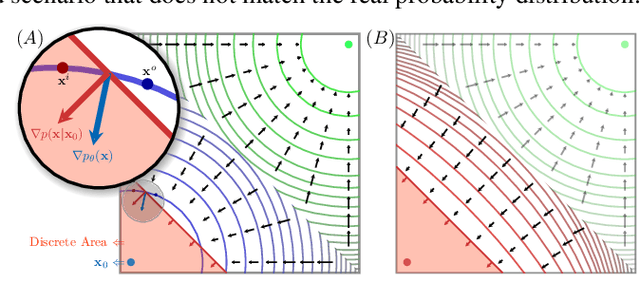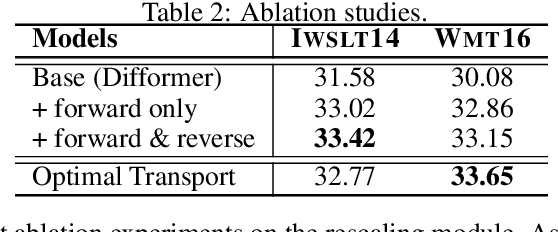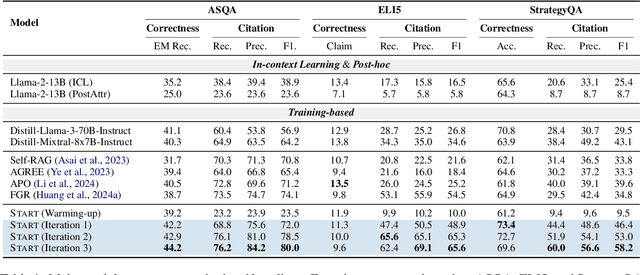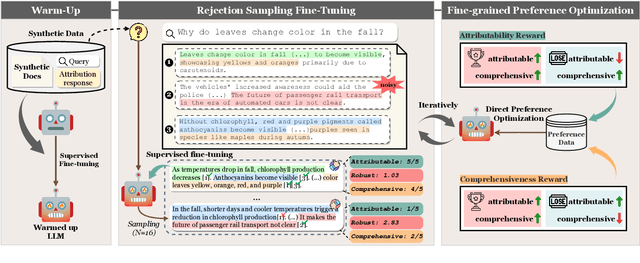Xiaocheng Feng
Enhancing Non-English Capabilities of English-Centric Large Language Models through Deep Supervision Fine-Tuning
Mar 05, 2025Abstract:Large language models (LLMs) have demonstrated significant progress in multilingual language understanding and generation. However, due to the imbalance in training data, their capabilities in non-English languages are limited. Recent studies revealed the English-pivot multilingual mechanism of LLMs, where LLMs implicitly convert non-English queries into English ones at the bottom layers and adopt English for thinking at the middle layers. However, due to the absence of explicit supervision for cross-lingual alignment in the intermediate layers of LLMs, the internal representations during these stages may become inaccurate. In this work, we introduce a deep supervision fine-tuning method (DFT) that incorporates additional supervision in the internal layers of the model to guide its workflow. Specifically, we introduce two training objectives on different layers of LLMs: one at the bottom layers to constrain the conversion of the target language into English, and another at the middle layers to constrain reasoning in English. To effectively achieve the guiding purpose, we designed two types of supervision signals: logits and feature, which represent a stricter constraint and a relatively more relaxed guidance. Our method guides the model to not only consider the final generated result when processing non-English inputs but also ensure the accuracy of internal representations. We conducted extensive experiments on typical English-centric large models, LLaMA-2 and Gemma-2, and the results on multiple multilingual datasets show that our method significantly outperforms traditional fine-tuning methods.
From Hypothesis to Publication: A Comprehensive Survey of AI-Driven Research Support Systems
Mar 03, 2025Abstract:Research is a fundamental process driving the advancement of human civilization, yet it demands substantial time and effort from researchers. In recent years, the rapid development of artificial intelligence (AI) technologies has inspired researchers to explore how AI can accelerate and enhance research. To monitor relevant advancements, this paper presents a systematic review of the progress in this domain. Specifically, we organize the relevant studies into three main categories: hypothesis formulation, hypothesis validation, and manuscript publication. Hypothesis formulation involves knowledge synthesis and hypothesis generation. Hypothesis validation includes the verification of scientific claims, theorem proving, and experiment validation. Manuscript publication encompasses manuscript writing and the peer review process. Furthermore, we identify and discuss the current challenges faced in these areas, as well as potential future directions for research. Finally, we also offer a comprehensive overview of existing benchmarks and tools across various domains that support the integration of AI into the research process. We hope this paper serves as an introduction for beginners and fosters future research. Resources have been made publicly available at https://github.com/zkzhou126/AI-for-Research.
SLAM: Towards Efficient Multilingual Reasoning via Selective Language Alignment
Jan 07, 2025Abstract:Despite the significant improvements achieved by large language models (LLMs) in English reasoning tasks, these models continue to struggle with multilingual reasoning. Recent studies leverage a full-parameter and two-stage training paradigm to teach models to first understand non-English questions and then reason. However, this method suffers from both substantial computational resource computing and catastrophic forgetting. The fundamental cause is that, with the primary goal of enhancing multilingual comprehension, an excessive number of irrelevant layers and parameters are tuned during the first stage. Given our findings that the representation learning of languages is merely conducted in lower-level layers, we propose an efficient multilingual reasoning alignment approach that precisely identifies and fine-tunes the layers responsible for handling multilingualism. Experimental results show that our method, SLAM, only tunes 6 layers' feed-forward sub-layers including 6.5-8% of all parameters within 7B and 13B LLMs, achieving superior average performance than all strong baselines across 10 languages. Meanwhile, SLAM only involves one training stage, reducing training time by 4.1-11.9 compared to the two-stage method.
Ensuring Consistency for In-Image Translation
Dec 24, 2024Abstract:The in-image machine translation task involves translating text embedded within images, with the translated results presented in image format. While this task has numerous applications in various scenarios such as film poster translation and everyday scene image translation, existing methods frequently neglect the aspect of consistency throughout this process. We propose the need to uphold two types of consistency in this task: translation consistency and image generation consistency. The former entails incorporating image information during translation, while the latter involves maintaining consistency between the style of the text-image and the original image, ensuring background integrity. To address these consistency requirements, we introduce a novel two-stage framework named HCIIT (High-Consistency In-Image Translation) which involves text-image translation using a multimodal multilingual large language model in the first stage and image backfilling with a diffusion model in the second stage. Chain of thought learning is utilized in the first stage to enhance the model's ability to leverage image information during translation. Subsequently, a diffusion model trained for style-consistent text-image generation ensures uniformity in text style within images and preserves background details. A dataset comprising 400,000 style-consistent pseudo text-image pairs is curated for model training. Results obtained on both curated test sets and authentic image test sets validate the effectiveness of our framework in ensuring consistency and producing high-quality translated images.
Cross-Lingual Text-Rich Visual Comprehension: An Information Theory Perspective
Dec 23, 2024



Abstract:Recent Large Vision-Language Models (LVLMs) have shown promising reasoning capabilities on text-rich images from charts, tables, and documents. However, the abundant text within such images may increase the model's sensitivity to language. This raises the need to evaluate LVLM performance on cross-lingual text-rich visual inputs, where the language in the image differs from the language of the instructions. To address this, we introduce XT-VQA (Cross-Lingual Text-Rich Visual Question Answering), a benchmark designed to assess how LVLMs handle language inconsistency between image text and questions. XT-VQA integrates five existing text-rich VQA datasets and a newly collected dataset, XPaperQA, covering diverse scenarios that require faithful recognition and comprehension of visual information despite language inconsistency. Our evaluation of prominent LVLMs on XT-VQA reveals a significant drop in performance for cross-lingual scenarios, even for models with multilingual capabilities. A mutual information analysis suggests that this performance gap stems from cross-lingual questions failing to adequately activate relevant visual information. To mitigate this issue, we propose MVCL-MI (Maximization of Vision-Language Cross-Lingual Mutual Information), where a visual-text cross-lingual alignment is built by maximizing mutual information between the model's outputs and visual information. This is achieved by distilling knowledge from monolingual to cross-lingual settings through KL divergence minimization, where monolingual output logits serve as a teacher. Experimental results on the XT-VQA demonstrate that MVCL-MI effectively reduces the visual-text cross-lingual performance disparity while preserving the inherent capabilities of LVLMs, shedding new light on the potential practice for improving LVLMs. Codes are available at: https://github.com/Stardust-y/XTVQA.git
Length Controlled Generation for Black-box LLMs
Dec 19, 2024



Abstract:Large language models (LLMs) have demonstrated impressive instruction following capabilities, while still struggling to accurately manage the length of the generated text, which is a fundamental requirement in many real-world applications. Existing length control methods involve fine-tuning the parameters of LLMs, which is inefficient and suboptimal for practical use. In this paper, we propose a novel iterative sampling framework for text length control, integrating the Metropolis-Hastings algorithm with an importance sampling acceleration strategy. This framework efficiently and reliably regulates LLMs to generate length-constrained text without modifying the underlying parameters, thereby preserving the original capabilities of LLMs. Experimental results demonstrate that our framework achieves almost 100\% success rates of length control on Llama3.1 for tasks such as length-controlled abstractive summarization and length-constrained instruction following, with minimal additional computational overhead. This also highlights the significant potential of our method for precise length control across a broader range of applications, without compromising the versatility of LLMs.
XTransplant: A Probe into the Upper Bound Performance of Multilingual Capability and Culture Adaptability in LLMs via Mutual Cross-lingual Feed-forward Transplantation
Dec 17, 2024Abstract:Current large language models (LLMs) often exhibit imbalances in multilingual capabilities and cultural adaptability, largely due to their English-centric pretraining data. To address this imbalance, we propose a probing method named XTransplant that explores cross-lingual latent interactions via cross-lingual feed-forward transplantation during inference stage, with the hope of enabling the model to leverage the strengths of both English and non-English languages. Through extensive pilot experiments, we empirically prove that both the multilingual capabilities and cultural adaptability of LLMs hold the potential to be significantly improved by XTransplant, respectively from En -> non-En and non-En -> En, highlighting the underutilization of current LLMs' multilingual potential. And the patterns observed in these pilot experiments further motivate an offline scaling inference strategy, which demonstrates consistent performance improvements in multilingual and culture-aware tasks, sometimes even surpassing multilingual supervised fine-tuning. And we do hope our further analysis and discussion could help gain deeper insights into XTransplant mechanism.
CoMT: A Novel Benchmark for Chain of Multi-modal Thought on Large Vision-Language Models
Dec 17, 2024Abstract:Large Vision-Language Models (LVLMs) have recently demonstrated amazing success in multi-modal tasks, including advancements in Multi-modal Chain-of-Thought (MCoT) reasoning. Despite these successes, current benchmarks still follow a traditional paradigm with multi-modal input and text-modal output, which leads to significant drawbacks such as missing visual operations and vague expressions. Motivated by this, we introduce a novel Chain of Multi-modal Thought (CoMT) benchmark to address these limitations. Different from the traditional MCoT benchmark, CoMT requires both multi-modal input and multi-modal reasoning output, aiming to mimic human-like reasoning that inherently integrates visual operation. Specifically, CoMT consists of four categories: (1) Visual Creation, (2) Visual Deletion, (3) Visual Update, and (4) Visual Selection to comprehensively explore complex visual operations and concise expression in real scenarios. We evaluate various LVLMs and strategies on CoMT, revealing some key insights into the capabilities and limitations of the current approaches. We hope that CoMT can inspire more research on introducing multi-modal generation into the reasoning process.
Discrete Modeling via Boundary Conditional Diffusion Processes
Oct 29, 2024



Abstract:We present an novel framework for efficiently and effectively extending the powerful continuous diffusion processes to discrete modeling. Previous approaches have suffered from the discrepancy between discrete data and continuous modeling. Our study reveals that the absence of guidance from discrete boundaries in learning probability contours is one of the main reasons. To address this issue, we propose a two-step forward process that first estimates the boundary as a prior distribution and then rescales the forward trajectory to construct a boundary conditional diffusion model. The reverse process is proportionally adjusted to guarantee that the learned contours yield more precise discrete data. Experimental results indicate that our approach achieves strong performance in both language modeling and discrete image generation tasks. In language modeling, our approach surpasses previous state-of-the-art continuous diffusion language models in three translation tasks and a summarization task, while also demonstrating competitive performance compared to auto-regressive transformers. Moreover, our method achieves comparable results to continuous diffusion models when using discrete ordinal pixels and establishes a new state-of-the-art for categorical image generation on the Cifar-10 dataset.
Advancing Large Language Model Attribution through Self-Improving
Oct 17, 2024



Abstract:Teaching large language models (LLMs) to generate text with citations to evidence sources can mitigate hallucinations and enhance verifiability in information-seeking systems. However, improving this capability requires high-quality attribution data, which is costly and labor-intensive. Inspired by recent advances in self-improvement that enhance LLMs without manual annotation, we present START, a Self-Taught AttRibuTion framework for iteratively improving the attribution capability of LLMs. First, to prevent models from stagnating due to initially insufficient supervision signals, START leverages the model to self-construct synthetic training data for warming up. To further self-improve the model's attribution ability, START iteratively utilizes fine-grained preference supervision signals constructed from its sampled responses to encourage robust, comprehensive, and attributable generation. Experiments on three open-domain question-answering datasets, covering long-form QA and multi-step reasoning, demonstrate significant performance gains of 25.13% on average without relying on human annotations and more advanced models. Further analysis reveals that START excels in aggregating information across multiple sources.
 Add to Chrome
Add to Chrome Add to Firefox
Add to Firefox Add to Edge
Add to Edge